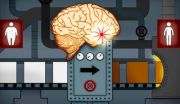Hunger games: How the brain 'browns' fat to aid weight loss
2014-10-09
(Press-News.org) Researchers at Yale School of Medicine have uncovered a molecular process in the brain known to control eating that transforms white fat into brown fat. This process impacts how much energy we burn and how much weight we can lose. The results are published in the Oct. 9 issue of the journal Cell.
Obesity is a rising global epidemic. Excess fatty tissue is a major risk factor for type 2 diabetes, cardiovascular disease, hypertension, neurological disorders, and cancer. People become overweight and obese when energy intake exceeds energy expenditure, and excess calories are stored in the adipose tissues, which are made up of both white and brown fat. While white fat primarily stores energy as triglycerides, brown fat dissipates chemical energy as heat. The more brown fat you have, the more weight you can lose.
It has previously been shown that energy-storing white fat has the capacity to transform into energy-burning "brown-like" fat. In this new study, researchers from the Yale Program in Integrative Cell Signaling and Neurobiology of Metabolism, demonstrate that neurons controlling hunger and appetite in the brain control the "browning" of white fat.
Lead author Xiaoyong Yang, associate professor of comparative medicine and physiology at Yale School of Medicine, conducted the study with Tamas Horvath, professor and chair of comparative medicine, and professor of neurobiology and Obstetrics/gynecology at Yale School of Medicine, and their co-authors.
The team stimulated this browning process from the brain in mice and found that it protected the animals from becoming obese on a high-fat diet. The team then studied the molecular changes in hunger-promoting neurons in the hypothalamus and found that the attachment of a unique sugar called "O-GlcNAc" to potassium ion channels acts as a switch to control brain activity to burn fat.
"Our studies reveal white fat "browning" as a highly dynamic physiological process that the brain controls," said Yang. "This work indicates that behavioral modifications promoted by the brain could influence how the amount of food we eat and store in fat is burned."
Yang said hunger and cold exposure are two life-history variables during the development and evolution of mammals. "We observed that food deprivation dominates over cold exposure in neural control of white fat browning. This regulatory system may be evolutionarily important as it can reduce heat production to maintain energy balance when we are hungry. Modulating this brain-to-fat connection represents a potential novel strategy to combat obesity and associated illnesses."
INFORMATION:
Other authors on the study include Hai-Bin Ruan, Marcelo O. Dietrich, Zhong-Wu Liu, Marcelo R. Zimmer, Min-Dian Li, Jay Prakash Singh, Kaisi Zhang, Ruonan Yin, and Jing Wu.
The study was funded by the National Institutes of Health, American Diabetes Association, Ellison Medical Foundation, American Heart Association, and CNPq/Brazil.
[Attachments] See images for this press release:

ELSE PRESS RELEASES FROM THIS DATE:
2014-10-09
Harvard stem cell researchers today announced that they have made a giant leap forward in the quest to find a truly effective treatment for type 1 diabetes, a condition that affects an estimated three million Americans at a cost of about $15 billion annually:
With human embryonic stem cells as a starting point, the scientists are for the first time able to produce, in the kind of massive quantities needed for cell transplantation and pharmaceutical purposes, human insulin-producing beta cells equivalent in most every way to normally functioning beta cells.
Doug Melton, ...
2014-10-09
CAMBRIDGE, Mass. (October 9, 2014) – Within almost every human cell is a nucleus six microns in diameter—about one 300th of a human hair's width—that is filled with roughly three meters of DNA. As the instructions for all cell processes, the DNA must be accessible to the cell's transcription machinery yet be compressed tightly enough to fit inside the nucleus. Scientists have long theorized that the way DNA is packaged affects gene expression. Whitehead Institute researchers present the first evidence that DNA scaffolding is responsible for enhancing and ...
2014-10-09
BOSTON – The surprising discovery of a previously unidentified class of lipid molecules that enhance insulin sensitivity and blood sugar control offers a promising new avenue for the prevention and treatment of type 2 diabetes.
The new findings, made by a team of scientists from Beth Israel Deaconess Medical Center (BIDMC) and the Salk Institute, are described in the October 9 online issue of the journal Cell.
"We were blown away to discover this completely new class of molecules," says senior author Barbara Kahn, MD, Vice Chair of the Department of Medicine ...
2014-10-09
Beer yeasts produce chemicals that mimic the aroma of fruits in order to attract flies that can transport the yeast cells to new niches, report scientists from VIB, KU Leuven and NERF in the reputed journal Cell Reports. Interestingly, these volatile compounds are also essential for the flavor of beverages such as beer and wine.
Kevin Verstrepen (VIB/KU Leuven): "The importance of yeast in beer brewing has long been underestimated. But recent research shows that the choice of a particular yeast strain or variety explains differences in taste between different beers and ...
2014-10-09
A key mechanism behind diabetes may start in the brain, with early signs of the disease detectable through rising levels of molecules not previously linked to insulin signaling, according to a study led by researchers at the Icahn School of Medicine at Mount Sinai published today in the journal Cell Metabolism.
Past studies had found that levels of a key set of protein building blocks, branched-chain amino acids (BCAAs), are higher in obese and diabetic patient, and that this rise occurs many years before someone develops diabetes. Why and how BCAA breakdown may be ...
2014-10-09
NEW YORK, NY (October 9, 2014)—Using an innovative algorithm that analyzes gene regulatory and signaling networks, Columbia University Medical Center (CUMC) researchers have found that loss of a gene called KLHL9 is the driving force behind the most aggressive form of glioblastoma, the most common form of brain cancer. The CUMC team demonstrated in mice transplants that these tumors can be suppressed by reintroducing KLHL9 protein, offering a possible strategy for treating this lethal disease. The study was published today in the online issue of Cell.
The team used ...
2014-10-09
VIDEO:
Salk researchers explain how a new class of lipids may be tied to diabetes.
Click here for more information.
LA JOLLA—Scientists at the Salk Institute and Beth Israel Deaconess Medical Center (BIDMC) in Boston have discovered a new class of molecules—produced in human and mouse fat—that protects against diabetes.
The researchers found that giving this new fat, or lipid, to mice with the equivalent of type 2 diabetes lowered their elevated blood sugar, ...
2014-10-09
New Rochelle, NY, October 9, 2014—Excessive and often lethal blood levels of bilirubin can result from mutations in a single gene that are the cause of the metabolic disease known as Crigler-Najjar syndrome type 1 (CNS1). A new gene therapy approach to correcting this metabolic error achieved significant, long-lasting reductions in bilirubin levels in a mouse model of CNS1 and is described in an Open Access article in Human Gene Therapy, a peer-reviewed journal from Mary Ann Liebert, Inc., publishers. The article is available on the Human Gene Therapy website at http://online.liebertpub.com/doi/full/10.1089/hum.2013.233. ...
2014-10-09
TIFTON, GA – Weed control is one of the most challenging aspects of organic crop production. Most growers of certified organic crops rely heavily on proven cultural and mechanical weed control methods while limiting the use of approved herbicides. A new study of herbicides derived from clove oil tested the natural products' effectiveness in controlling weeds in Vidalia® sweet onion crops.
"Cultivation with a tine weeder and hand weeding are the primary tools currently used for weed control in organic sweet onion (Allium ceps)," explained scientist W. Carroll ...
2014-10-09
IZMIR, TURKEY – Tomatoes are known to be rich in antioxidants such as vitamin C, lycopene, β-carotene, and phenolics. Antioxidants, substances capable of delaying or inhibiting oxidation processes caused by free radicals, are of interest to consumers for their health-related contributions, and to plant breeders for their ability to provide plants with natural resistance to biotic and abiotic stresses. While tomato domestication and breeding programs have typically focused on traits such as fruit weight, color, shape, and disease resistance, scientists are now ...
LAST 30 PRESS RELEASES:
[Press-News.org] Hunger games: How the brain 'browns' fat to aid weight loss





